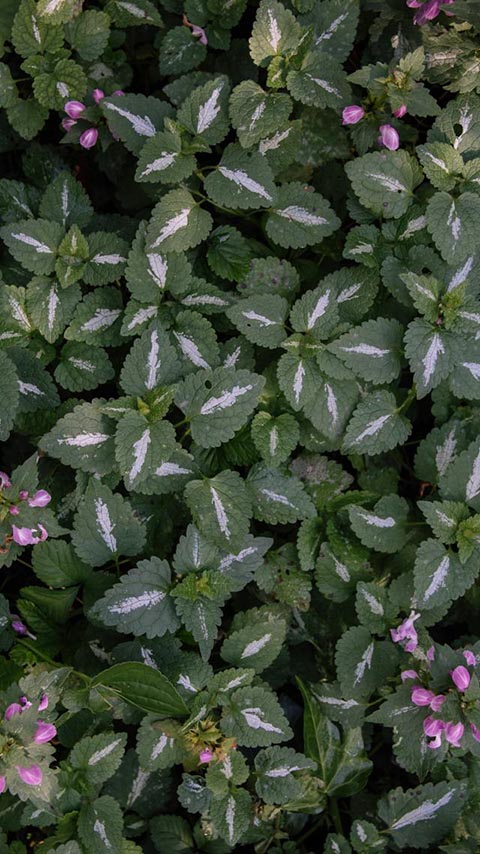Rest assured that purple spotted dead nettle is non-toxic to dogs and cats. We check the flowers we feature on our site with the ASPCA and do extensive internet research for both the common and scientific name just to be super pet safe. If we cannot find direct reference, we check up to genus and so on until we can confirm whether a plant is toxic or non toxic to both cats and dogs. If we are not sure, or get contradictory information, we do not include it. Many of the plants featured we have grown successfully in our own pet safe garden in Northern California. You can see many of garden stars in photos from Lovie’s Pet Safe Garden.

Physical Attributes
- Height: 6-9 inches (15-23 cm) tall
- Spread: 2-3 feet (60-90 cm)
- Leaves: Heart-shaped, variegated, often silver or white with green edges
- Flowers: Small, hooded, in whorls; pink, purple, or white
- Stem: Square, hollow, trailing
- Growth habit: Low-growing, spreading groundcover
- Foliage: Evergreen in mild climates, semi-evergreen elsewhere
General Care Tips
- Light: Partial sun to full shade
- Soil: Well-drained, moist, slightly acidic
- Water: Average moisture; more in sunnier locations
- Hardiness: USDA zones 3-8
- Pruning: Remove reverted all-green leaves
- Propagation: Division or stem cuttings
- Maintenance: Low; control spread if necessary
- Companion plants: Hostas, ferns, astilbe, hellebores
Fun Facts
- Not related to stinging nettles despite the name “dead nettle”
- Member of the mint family (Lamiaceae)
- Attracts bees, especially bumblebees
- Used as a groundcover to suppress weeds
- Some varieties have leaves that are almost entirely silver
- Can be used in hanging baskets or as a container plant
- Deer and rabbit resistant
- Native to Europe and temperate regions of Asia
- Name “Lamium” comes from the Greek word for “throat”
- Historically used in herbal medicine for various ailments
Here’s a table with two columns addressing the considerations for Spotted Dead Nettle (Lamium maculatum) flowering plant:
| Consideration | Answer |
|---|---|
| Container Friendly | Yes |
| Indoor/Outdoor | Primarily outdoor |
| Sun/Shade | Partial sun to full shade |
| Perennial/Annual | Perennial |
| Flowering | Mid-spring to early summer, sporadically into fall |
| Drought Tolerant | Moderate, prefers moist soil |
| Pollinator Magnet | Yes, attracts bees |
| Beginner Friendly | Yes, low maintenance |
| Good Ground Cover | Excellent |
| Good Privacy Screen | No, low-growing (6-9 inches tall) |
| Invasive/Spreader | Can spread quickly, may be invasive in some areas |
| Hearty/Delicate | Hearty |
| Rodent Repellant | No specific information available |
| Deer Resistant | Yes |
| Native To | Europe and temperate regions of Asia |
| Ideal States/Regions | USDA zones 3-8, adaptable to many regions |
Citations:
[1] https://www.wildflower.org/plants/result.php?id_plant=COHE
[2] https://mortonarb.org/plant-and-protect/trees-and-plants/spotted-dead-nettle/
[3] https://larnerseeds.com/products/collinsia-heterophylla-purple-chinese-houses
[4] https://naturecollective.org/plant-guide/details/chinese-houses/
[5] https://www.gardenia.net/plant/lamium-maculatum-spotted-dead-nettle
[6] https://www.gardenia.net/plant/lamium-maculatum-spotted-dead-nettle
[7] https://mortonarb.org/plant-and-protect/trees-and-plants/spotted-dead-nettle/
[8] https://hort.extension.wisc.edu/articles/spotted-deadnettle-lamium-maculatum/
[9] https://www.mckaynursery.com/deadnettle
[10] https://www.thespruce.com/spotted-dead-nettles-2132591





